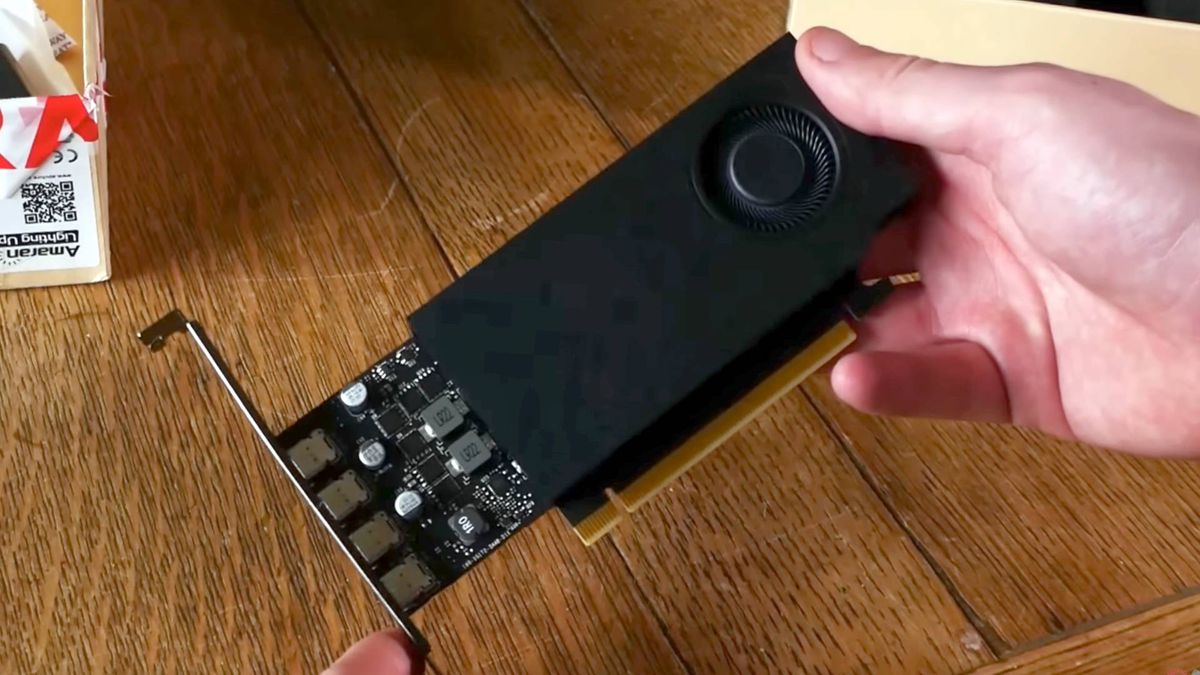The Nvidia GeForce RTX 4010 is a budget GPU that can run Crysis at 80fps without compromise, but it technically doesn't exist
It can also pull off ray tracing (just not very well)

I didn't have coming across an Nvidia GeForce RTX 4010 graphics card ahead of the RTX 50-series launch on my bingo card. Yet, here I am about to show you all a GPU that shouldn't exist, one that's extremely low power while packing ray tracing abilities. The best part is apparently only comes in at between $80 and $100, which is remarkable for a card that can keep up with your old PS4.
As showcased in a video by one of my favorite YouTubers, Budget-builds official, the "RTX 4010" is naturally not an official best graphics card contender. Instead, it's a seemingly modified version of Nvidia's A400 workstation GPU armed with 4GB GDDR6 VRAM and a GA107 chip. It's worth noting that the green team's cheap card can't normally be used for gaming, but that's where things get interesting with this unofficial newcomer.
After taking a chance on the RTX 4010 via a Chinese seller for science, Budget-Builds reveals that the modified card actually uses RTX 4090 D drivers to make gaming possible. Both GeForce Experience and applications like GPU-Z recognize it as such, meaning there's nothing stopping you from putting its Ampere GPU to work in games.
As for what the "RTX 4010" can actually do for your cheap gaming PC, well, I'm taken back by how capable a GPU like this actually is. Before you get excited about its apparent ray-tracing abilities, just know that they're naturally a bit redundant in a card with these specs. However, performance to me feels pretty much on par with last-gen consoles like the PS4 and Xbox One, which is bananas since this 50W card can power itself solely off your motherboard.
Some highlights from Budget-builds' benchmarking bonanza include Red Dead Redemption 2 running at 33fps with 1080p ultra settings enabled, Baldur's Gate 3 managing a 44fps average set at high, and GTA Online maintaining 60fps. That latter result is pretty fantastic since Rockstar's sandbox can normally be taxing when it comes to online multiplayer, but the card is more than up to providing a low-spec PC experience.
The real novelty, however, is the RTX 4010 can run Crysis at 80fps with high settings enabled. Yes, that old meme holds less meaning in a world with tricky-to-run outings like Cyberpunk 2077, but it feels like only yesterday that ridiculous rigs were required to run the shooter. Put it this way - if I traveled back in time with both an RTX 4090 and this tiny cheap card in hand and showed a bunch of LAN goers their abilities, I think they'd be more surprised by the latter.



Circling back to ray tracing, and getting Portal RTX up and running did mean dropping way back to 480p low settings. Hardly ideal, but the card hasn't got access to DLSS upscaling, meaning it isn't quite on a level footing with other contemporary cards here. Plus, the RT cores really only exist for non-gaming purposes here, so you're going to still want to look at the RTX 4060 if you want affordable fancy lighting.
Sign up to the 12DOVE Newsletter
Weekly digests, tales from the communities you love, and more
As for whether you should actually buy an RTX 4010? Every fiber of my being wants to say yes, but this is a modified card from China that comes without a warranty. Therefore, unless you are an enthusiast who doesn't care about consumer risks, or just loves experimenting with smaller builds, I'd perhaps stick to official cards for now. What I will say is that this unofficial budget GPU has me craving more true entry-level options in the generation ahead.
Yes, I'm excited for the RTX 5090 and the monstrous abilities it'll likely provide, but if Nvidia can cook up an official version of this "RTX 4010" with a Lovelace chip, I'll be ecstatic.
Searching for more upgrades? Swing by the best gaming CPU and best RAM for gaming for ways to revamp your rig. Alternatively, take a peek at the best gaming handhelds for portable Windows machines.

I’ve been messing around with PCs, video game consoles, and tech since before I could speak. Don’t get me wrong, I kickstarted my relationship with technology by jamming a Hot Wheels double-decker bus into my parent’s VCR, but we all have to start somewhere. I even somehow managed to become a walking, talking buyer’s guide at my teenage supermarket job, which helped me accept my career fate. So, rather than try to realise my musician dreams, or see out my University degree, I started running my own retro pop culture site and writing about video games and tech for the likes of TechRadar, The Daily Star, and the BBC before eventually ending up with a job covering graphics card shenanigans at PCGamesN. Now, I’m your friendly neighbourhood Hardware Editor at GamesRadar, and it’s my job to make sure you can kick butt in all your favourite games using the best gaming hardware, whether you’re a sucker for handhelds like the Steam Deck and Nintendo Switch or a hardcore gaming PC enthusiast.

Former Witcher 3 lead says his new vampire RPG Blood of Dawnwalker has a smaller open world because "it feels more like you actually know the place" compared to "behemoths"

Hades 2 devs say "we have not recast any of our characters" in the roguelike amid concerns during the ongoing SAG-AFTRA video game strike
Most Popular







